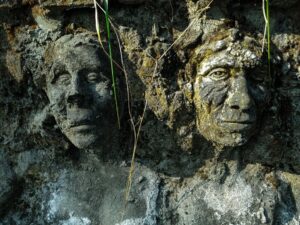When Did People First Begin to Communicate With One Another? The History of Language Development in Africa

When did people initially begin to speak, which sounds of speech were the first to be uttered, and when did communication develop from those early, simple beginnings? People have been interested in these questions for a very long time, particularly when it comes to identifying the development of modern humans and determining what sets us apart from other animals.
Researching the phonetics and lingual frameworks of African languages has taken up the majority of George Poulos’ time during his academic career. New hypotheses regarding the development of language are presented in the author’s most recent book, titled On the Origins of Human Speech and Language. We questioned him about the findings he had obtained.
Where and When Did the Development of Human Speech Begin?
The research that was carried out for this study suggests that the first speech sounds were uttered approximately 70,000 years ago. Around the same time that our forebears left Africa in search of new hunting and gathering grounds, Homo sapiens, also known as modern humans, evolved from a “non-speaking” to a “speaking” species.
They brought with them the ultimate gift ever obtained by our species: the ability to generate speech sounds, which was made possible by the creation of a gene called “speech.” When those early explorers migrated further than the African continent, they took along the capacity to produce speech sounds. It was primarily due to this ability that they were able to propel themselves into a position in which they would eventually rule all other species on the planet.
What Sonic Components of Early Speech Came First?
The very first sounds that were ever produced that could be classified as speech were not simply involuntary noises. A nascent neural network, which linked various regions of the brain to various components of the vocal tract, was operating in the background while these speech sounds were being produced. The ability of Homo sapiens to generate speech sounds for the very first time was the result of multiple skeletal and environmental factors coming together.
An apparent shift in the nutrition of our primitive ancestors and the potential influence that this might have had on the development of the human brain is another factor that is interesting to consider. When early humans moved from the interior of the continent to the coastlines, they made the transition to what was primarily an ocean diet rich in omega-3 fatty acids.
The vocal tract gradually developed over an extended period, and the varying phases in its advancement decided the kinds of sounds that could be created then. The oral cavity was the sole component of the vocal cords that were physiologically established to generate speech sounds at the time of the “out of Africa” migration.
What Is Known As the Click Sound
At that time, the so-called “click” sound was the only type of speech sound that could be formed completely in the mouth by a human being. The flow of air could be manipulated from within the mouth itself. There are no other recognized speech sounds that operate in this manner other than clicks. They are preserved to this day in a small number of African languages, most prominently in the Khoisan language families that are spoken in certain regions of Botswana, Namibia, and South Africa.
There is fewer than one percent of the world’s languages use clicks. They are also found in a few isolated cases in East Africa, as well as in certain South African languages that introduced the clicks after coming into contact with Khoisan speakers. In one example outside of Africa, clicks were recorded in a ceremonial linguistic record known as Damien in Australia, which is now extinct.
The so-called “kiss” click, also known as the bilabial click, is an example of a click speech sound. During this click, the lips are brought together, and the rear of the tongue is raised against the roof of the mouth. After that, the lips are drawn in ever-so-slightly, and when the suction is released, a click sound is created. A schematic representation of the human head highlights the mouth and the three stages that comprise the production of sound.
The Generation of the Click is Produced by the Alveolar Ridge
According to the findings of my research, the “kiss” click was most likely the first sound that Homo sapiens ever produced that could be classified as speech. As time passed, the different parts of the tongue progressively became more movable, which made it possible for other click sounds to be generated in the mouth in addition to the original ones.
When Did the Emergence of the Other Sounds of Speech Occur?
According to the findings of this study, the creation of all the other sounds that make up human speech (including all of the vowels and the other consonants) first started around 50,000 years ago. This was reliant on the slow evolution of a well-proportioned vocal tract, including the mouth, the area behind the mouth (the pharynx), the nasal cavity, and the crucial larynx with its vocal cords. This development took place over some time. Three airstream mechanisms progressed for the production of all speaking sounds, and their development occurred gradually in stages that succeeded one another.
How Did People Communicate Before the Invention of the Click?
Before this, the only sounds that humans were capable of producing were what are now referred to as “vocalizations” or vocal calls. These were replicas or mimics of a variety of actions or noises that humans had been subjected to in their surrounding environment.
It’s possible that they were involuntary sounds that expressed different emotions, like yawning or sneezing, or that they were sounds that people make when they can’t help but make them. These ought not to be confused with the extremely complex methods that are involved in the generation of speech sounds, which are the fundamentals of what we know today to be human language. These must be kept completely separate from one another.
What About the Utilization of Fully-formed Grammatical Language?
As time went on, different sounds of speech combined in a variety of distinct ways to form syllables and eventually words. These, in turn, merged in a variety of ways to produce the structural types of grammatical phrases that are characteristic of modern languages.
The earliest humans were able to produce sounds associated with speech, which served as the impetus for the gradual development of language. The development of grammatical language did not occur all at once. There was not a “single silver bullet” that was responsible for the generation of language.
The evidence suggests that Homo sapiens did not acquire language until a relatively late stage in their evolution. According to the findings of this study, the development of language in its modern form most likely started somewhere around 20,000 years ago.
There is currently no significant phonetic or linguistic evidence to suggest that other species, such as the Neanderthals, may have spoken a grammatical language. They did not possess the dimensions of the vocal tract necessary for the production of speech sounds, not to mention the morphological and syntactic structures that are necessary for the comprehension of grammatical language.
What is the Significance of All of This?
The production of the very first sounds associated with speech occurred approximately 70,000 years ago. This marked the beginning of the process that would eventually result in the development of human language.
From the world’s earliest “written” records that we have direct exposure to (some 5,500 years ago) to the extremely sophisticated advances in technology that we are experiencing today, language has offered the communication tool that has played a crucial role in the monumental advances that have occurred.







